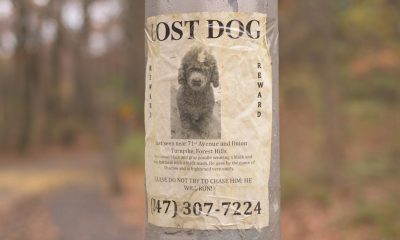Dogs trained to smell PTSD by sniffing someone’s breath
Our four-legged friends can be taught to recognize the scent of trauma reactions on human breath.
Published
4 weeks ago onBy
Talker News
By Stephen Beech via SWNS
Two dogs have been trained to sniff out post-traumatic stress - by smelling survivors’ breath.
A pilot study has shown that our four-legged friends can be taught to recognize the scent of trauma reactions on human breath.
Ivy, a Golden Retriever, and Callie, a German Shepherd cross Belgian Malinois mix, were the only two of 25 dogs "skilled and motivated enough" to complete the rigorous training process.
Scientists say the breakthrough will make post-traumatic stress disorder (PTSD) assistance dogs more effective.
PTSD is a mental health condition that's triggered by a terrifying event such as a car crash or terror attack, either experiencing it or witnessing it.
Symptoms may include flashbacks, nightmares and severe anxiety, as well as uncontrollable thoughts about the event.
Dogs’ sensitive noses can detect the early warning signs of many potentially dangerous medical situations, such as an impending seizure.
Now, scientists have found evidence that assistance dogs might even be able to sniff out an oncoming PTSD flashback, by teaching two dogs to alert to the breath of people who have been reminded of traumas.
Study first author Laura Kiiroja, of Dalhousie University, Canada, said: “PTSD service dogs are already trained to assist people during episodes of distress.
“However, dogs are currently trained to respond to behavioral and physical cues.

"Our study showed that at least some dogs can also detect these episodes via breath.”
She said assistance dogs can help patients by alerting to and interrupting episodes when their companions are struggling with their symptoms.
If dogs could respond to stress markers on the breath, the research team say they could potentially interrupt episodes at an earlier stage - making their interventions more effective.
All humans have a ‘scent profile’ of volatile organic compounds (VOCs) - molecules emitted by the body in secretions such as sweat - influenced by our genetics, age, activities, and other variables.
There is some evidence that dogs may be capable of detecting VOCs linked to human stress.
However, no studies have investigated whether dogs could learn to detect VOCs associated with PTSD symptoms.
Kiiroja said: “This is a multidisciplinary collaboration between Dr. Sherry Stewart’s clinical psychology lab and Dr Simon Gadbois’ canine olfaction lab, both at Dalhousie University.
“Neither lab could have done this work on their own. We brought together two distinct sets of expertise.”
The scientists recruited 26 people as scent donors. The participants were also taking part in a study about the reactions of people who have experienced trauma to reminders of that trauma; 54 percent met the diagnostic requirements for PTSD.
To donate scents, the participants attended sessions where they were reminded of their trauma experiences while wearing different facemasks.
One facemask provided a calm breath sample that acted as the control, while another, which was worn as the participants recalled their traumatic experience, provided a target breath sample.

The participants also completed a questionnaire about their stress levels and their emotions.
The research team recruited 25 pet dogs to train in scent detection. Only two, Ivy and Callie, completed the study.
Kiiroja, currently working on her PhD in biomedical scent-detection dogs, said: “Both Ivy and Callie found this work inherently motivating.
“Their limitless appetite for delicious treats was also an asset. In fact, it was much harder to convince them to take a break than to commence work.
"Callie in particular made sure there was no dilly-dallying.”
Ivy and Callie were trained to recognize the target odor from pieces of the facemasks.
They achieved 90 percent accuracy in discriminating between a stressed and a non-stressed sample, according to the study published by the journal Frontiers in Allergy.
The dogs were then presented with a series of samples, one at a time, to see if they could still accurately detect the stress VOCs.

In the second experiment, Ivy achieved 74 percent accuracy while Callie achieved 81 percent.
Comparing Callie and Ivy’s successful identifications with the human participants’ self-reported emotions revealed that Ivy’s performance correlated with anxiety, whereas Callie’s correlated with shame.
Kiiroja said: “Although both dogs performed at very high accuracy, they seemed to have a slightly different idea of what they considered a ‘stressed’ breath sample.
“We speculated that Ivy was attuned to sympathetic-adreno-medullar axis hormones - like adrenaline - and Callie was oriented to the hypothalamo-pituitary-adrenal axis hormones - like cortisol.
"This is important knowledge for training service dogs, as alerting to early-onset PTSD symptoms requires sensitivity to sympathetic-adreno-medullar axis hormones.”
The team now plans to carry out experiments to confirm the involvement of the sympathetic-adreno-medullar axis.
Kiiroja added: “With 40 sample sets, ours is a proof-of-concept study that needs to be validated by studies with larger sample sizes.
“In addition to enrolling more participants, validation studies should collect samples from a higher number of stressful events to confirm dogs’ ability to reliably detect stress VOCs in the breath of one human across different contexts.”
Stories and infographics by ‘Talker Research’ are available to download & ready to use. Stories and videos by ‘Talker News’ are managed by SWNS. To license content for editorial or commercial use and to see the full scope of SWNS content, please email [email protected] or submit an inquiry via our contact form.
You may like


Blood test can detect signs of knee condition 8 years before X-rays


Rare condition that stunts growth also reduces heart attack risk


Research reveals mice think just like human babies


Harvard study reveals how pollution raises risk of heart attack or stroke


Does taking the stairs instead of an elevator help you live longer?


Dog theft causes same emotional turmoil as losing a child: study
Other Stories


Blood test can detect signs of knee condition 8 years before X-rays
Early detection could lead to treatments that slow the progression of the most common form of arthritis.


Man captures ultra rare albino squirrel on camera
The white squirrel has red eyes so is thought to be an albino squirrel.


Adorable dog kicks his leg while he walks
A video captured the pup bouncing along the street of his native China.


Woman with rare ‘Sleeping Beauty’ condition sleeps every four hours
She was diagnosed at age 18 after years of struggling to stay awake in school and nodding off during class.


97-year-old veteran receives WWII service medal 80 years later
"We’re all so proud of Eve."
Top Talkers

 Parenting1 week ago
Parenting1 week agoSingle mom details struggles of feeding her 12 kids

 Lifestyle1 week ago
Lifestyle1 week agoWoman regrets her tattoo nightmare: ‘It’s horrendous’

 Health5 days ago
Health5 days agoNew study reveals ‘old age’ begins later than it used to

 Wildlife4 days ago
Wildlife4 days agoClever elephant returns visitor’s shoe that fell into enclosure

 Good News5 days ago
Good News5 days agoDisabled student takes first steps in 10 years on graduation stage

 Animals18 hours ago
Animals18 hours agoAdorable dog kicks his leg while he walks

 Entertainment2 days ago
Entertainment2 days agoWhat is the perfect movie length?

 Broadcast23 hours ago
Broadcast23 hours agoAre allergies interfering with your social life?
